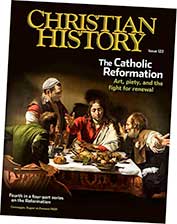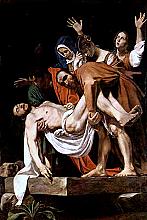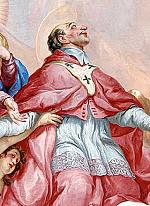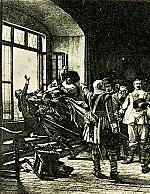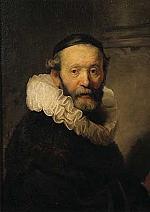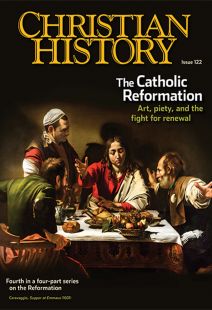The Persistent Council
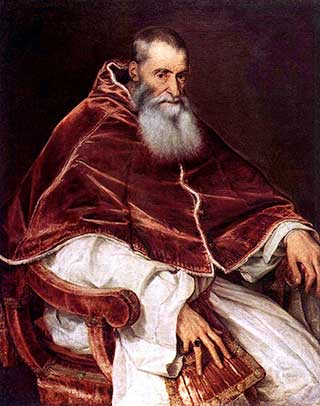
[Pope Paul III; Wikipedia]
THREE AND ONE HALF YEARS after its opening was first announced, a little over three years after bishops began trickling in, two years after it was suspended, one year after it was convoked again (producing a new trickle of bishops), and 10 months after its announced opening date, at 9:30 in the morning on December 13, 1545, the Council of Trent actually began. Four hundred bishops assembled in the Church of the Most Holy Trinity, sang the hymn “Come, Holy Spirit,” heard a reading of the papal bull Laetere, Jerusalem (1544) and a sermon, and celebrated Mass. The whole service took four and a half hours.
Getting off to a slow start
The council had trouble keeping going as well as getting going: it eventually met in three phases, 1545–1549, 1551–1552, and 1562–1563. Before his excommunication in 1521, Luther had formally appealed for a church council. Holy Roman Emperor Charles V condemned Luther, but also seconded Luther’s call for a council as the best way to settle the major religious divisions spreading across Europe. But popes in the early years of the Reformation refused to hold a council for several reasons. First, councils potentially undermined papal authority; all remembered the debates surrounding the Council of Constance in the early 1400s.
Second, even though Charles V was a devoted Catholic, he was also the king of Spain and head of the Habsburg Austro-Hungarian Empire. His immense political and religious power worried leaders in places like Italy, France, and England. The emperors had long-standing claims to leadership of the Christian world that rivaled those of the popes, and they had called Constance and other councils. If the emperor called a council in Germany, it might well be the beginning of a revived conciliarism (rule of the church by councils) that would definitively sideline the papacy.
Third, Catholics across Europe had diverse ideas about reform. Popes feared that a council might foster new conflicts rather than settle existing ones.
Compromise and plague
By the middle 1540s, when Pope Paul III (1468–1549) finally called the council, Protestantism was becoming established in northern Europe and England; the council focused more on reforming the Roman Catholic Church than finding unity with Protestants. The small city of Trent in northern Italy was selected as being within Charles’s lands but close to Rome and the Papal States. (Charles insisted on a location in the Holy Roman Empire to show his German subjects that this was indeed an open, universal council.)
Most bishops who attended the council came from Italy and Spain. Spain had already reformed its churches in previous decades, and Charles strongly supported the participation of Spanish bishops. Although no sitting popes visited the council, they oversaw it through the work of their legates (cardinals who set the agenda and wrote reports back to Rome).
Order Christian History #122: The Catholic Reformation in print.
Subscribe now to get future print issues in your mailbox (donation requested but not required).
The papal legates in the council’s first phase were Giovanni Maria Del Monte (1487–1555), Marcello Cervini (1501–1555), and the English exile Reginald Pole (1500–1558). Del Monte and Cervini later became popes themselves, and Pole served as the last Catholic archbishop of Canterbury under Mary I. Papal legates had a challenging dual role: keeping the popes satisfied that the council was not growing too independent, while assuring council participants of their freedom to deliberate and make decisions without papal interference.
Neither the pope nor the French liked having conceded to Charles V that the council take place in his domain. In early 1547 an outbreak of typhus threatened Trent; though the disease did not spread as feared, the legates used the excuse to move the council to the university town of Bologna, squarely within the Papal States.
This move met with majority approval from council participants and Pope Paul III. Nevertheless it dimmed the council’s prospects of coming to a swift and efficient close. Several bishops loyal to Charles remained in Trent out of protest. The council also moved during the exact months when Charles finally won a decisive military victory over German Lutheran princes. The result: extended delays and a suspension in 1549.
After Paul III’s death, Del Monte was elected pope. As Julius III he convened the council’s second period. Charles’s recent victory had now made it possible to invite Protestant theologians to attend the council without needing to guarantee them voting rights; a handful did so starting in 1551. In 1552, however, a military alliance between Henry II of France and German princes led by Maurice of Saxony undid Charles’s earlier victory. The new freedoms won by Protestants, along with renewed French-German hostilities, made continuation of the council unrealistic. It would not meet again for a decade.
Cervini, another former legate, was elected pope after Del Monte’s death and took the name Marcellus II, but died within the month. His successor, Paul IV (Gian Pietro Carafa), had attended the first session of the council and worked for reform, but his immoderate policies (see p. 40) and dislike of Charles meant he did not reconvene the council. Pope Pius IV (1499–1565), protégé of Paul III and uncle of Catholic reformer Charles Borromeo (1538–1584), finally opened the third period. It featured increased French participation and new leadership from the Jesuit order.
Let’s clean house
The Council of Trent took a twofold approach to reform. One group of participants—usually theologians and bishops with formal training—discussed doctrine, producing “canons,” while another group of bishops and advisors addressed worship and institutional reform in “decrees.” Occasional meetings known as “chapters” provided additional explanation of the issues. Finally both sets of drafting groups presented their statements to “sessions” (25 over the 18 years) where all voting members heard the proposals and voted on them.
Even before the Reformation, many had longed for a reform of institutional corruption and problematic worship practices. Particularly pressing issues included the ways popes like Alexander VI (1431–1503) and Julius II (1443–1513) had infamously used the papacy to promote family members and enrich their households. The papacy also charged fees for offices, especially additional dioceses. Trent renewed denunciation of simony (selling church offices) and nepotism (appointing family members)—though in practice even reforming popes like Paul III and Pius IV continued to privilege their relatives with jobs and finances.
The need for priests and bishops to live and work in their assigned dioceses was another key aspect of institutional reform. Over time the incomes and titles attached to congregations and dioceses had separated from the actual work of serving as parish priest or local bishop. A number of bishoprics and priestly offices suffered extended vacancies in which the appointed clergyman would never reside in the area, even though he received income for “holding the title.”
Priestly education was also very uneven. Though priests could study in universities or monastic communities, not everyone had access to or interest in such programs. No educational standard existed, either. Luther’s work at the University of Wittenberg, the circle of English reformers who gathered in Cambridge, and Calvin’s teaching ministry in Geneva had all spread by means of educational channels; in response the Council of Trent established strong seminaries to meet the need for an educated and pious Catholic clergy.
Haunted by Luther
Decrees on reform usually passed the voting sessions relatively easily, but canons on doctrine tended to cause more controversy. The specter of Martin Luther, who died just as the council was getting underway, haunted many of the theological issues debated: the canon of Scripture, the relationship between Scripture and tradition (the council reaffirmed the idea that the Word of God is found in both), and—of course—the doctrine of justification.
Many of the assembled theologians were familiar enough with Protestant writings that they could avoid overly simplistic caricatures of Protestant views. Among these were Pole and Girolamo Seripando (1493–1563), who was head of the Augustinian Order—the order to which Luther had belonged. Seripando was one of the few theologians to attend each period of the council.
The debate on justification included one of the wilder moments in the council’s history. Having used the phrase “by faith alone” in regard to justification, Bishop Tommaso Sanfelice overheard Bishop Dionisio de Zanettini call him a “knave or a fool.” Sanfelice confronted de Zanettini, grabbed his beard, and shook him violently. Sanfelice was expelled, not for his theology but for his unruly beard pulling.
Even after everyone calmed down, the canons on justification took nearly a year to formulate. They largely affirmed the standard teachings of late medieval Scholasticism. Trent agreed with the Protestants that we cannot save ourselves, but it affirmed that God’s sanctifying grace working in us, with our free cooperation, makes us worthy of eternal life. While the council did not identify Luther by name, it rejected outright central Lutheran teachings such as passive righteousness, justification by faith alone, and the certainty of faith.
Luther’s reform implicitly shaped much of the council’s agenda. The Roman Catholic Church had to take clear positions on issues such as the translation of the Bible into the vernacular, the marriage of priests, giving lay people the Eucharistic cup (not just the bread), indulgences, and purgatory. Nevertheless the Council of Trent in the end was not merely a reaction to Protestantism but an occasion for clarification and affirmation of Catholic teachings. Some practices associated with the period—the papal list of prohibited books and the insistence upon using the Latin Vulgate—took shape more under Pope Paul IV than as a result of Trent itself.
“It pleaseth us to go in peace”
Trent had a long-lasting, unifying effect. The primacy of the pope survived a great challenge; the focus on bishops and priests serving local communities brought renewed attention to grassroots faith; the invention of seminaries gave new shape to the formation and education of clergy; and the church’s patterns of doctrine and worship remained unchallenged until the equally monumental Second Vatican Council 400 years later.
On December 4, 1563, according to the council’s minutes, it was asked in conclusion:
Most illustrious lords and most reverend Fathers, doth it please you, that, to the praise of Almighty God, an end be put to this sacred ecumenical synod? and that the confirmation of … the things which have therein been decreed and defined … be requested … from the most blessed Roman Pontiff?
After the bishops answered in the affirmative, the minutes continue: “The most illustrious and most reverend Cardinal Morone … blessing the holy synod said: ‘After having given thanks to God, most reverend Fathers, go in peace.’” CH
This article is from Christian History magazine #122 The Catholic Reformation. Read it in context here!
Christian History’s 2015–2017 four-part Reformation series is available as a four-pack. This set includes issue #115 Luther Leads the Way; issue #118 The People’s Reformation; issue #120 Calvin, Councils, and Confessions; and issue#122 The Catholic Reformation. Get your set today. These also make good gifts.
By Martin J. Lohrmann
[Christian History originally published this article in Christian History Issue #122 in 2017]
Martin J. Lohrmann is assistant professor of Lutheran confessions and heritage at Wartburg Theological Seminary in Dubuque, Iowa; author of Book of Harmony; and coeditor of a volume in the Reformation Commentary on Scripture series.Next articles
Christian History Timeline: The Catholic Reformation
The Christian History Timeline compiled from issues 5, 12, 34, 39, 48, 115, and 118, with additions by the editors
the editorsDefender of God’s justice
Arminius questioned some aspects of Reformed faith, but he never meant to launch a movement
William den BoerSupport us
Christian History Institute (CHI) is a non-profit Pennsylvania corporation founded in 1982. Your donations support the continuation of this ministry
Donate



